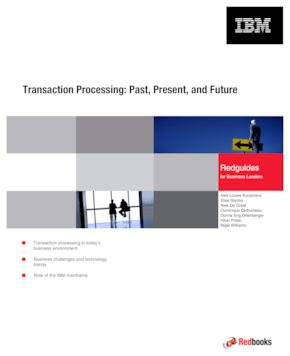Abstract
The role of IT is becoming more prominent in people’s daily lives and we are becoming increasingly dependent on computers. More and more business transactions are being automated, for example, ordering a book at an online bookstore or transferring money to a bank account in another part of the world. No matter the type of transaction, we want it to be accurate and we want to have no doubts about its outcome.
Transactions are also becoming more complex, driven by new ways of conducting business and new technologies. Smartphones now allow us to conduct transactions anywhere and at anytime. Technology paradigms, such as Web 2.0 and business event processing, enable businesses to increase the dynamics of a transaction through instrumentation that captures events, analyzes the associated data, and proactively interacts with the client in order to improve the customer experience. To adapt to the increasing volume and complexity of transactions requires an ongoing assessment of the current way of supporting transactions with IT.
No matter what your business is, you need to ensure that your transactions are properly completed with integrity. Wrong or incomplete results can adversely affect client loyalty, affect company profits, and lead to claims, lawsuits, or fines. Companies need to be able to rely on computer systems that are 100% reliable and guarantee transaction integrity at all times. The IBM® mainframe is such a platform.
Clients that have been using an IBM mainframe are conscious of its added value. For this IBM Redguide™ publication, we surveyed a number of companies that use the IBM mainframe and we asked them to tell us its most distinguishing qualities. They answered unanimously “reliability, availability, and scalability.” They also do not see an alternative for running their mission-critical business workloads other than the IBM mainframe.
When we surveyed our clients, we also asked them about the future. Clearly, major future trends demand significantly smarter, faster, and bigger transaction processing systems than we have today. Some of these trends are the availability of new computing paradigms, continuing growth of the mobile channel, further integration of organizations, massive growth of unstructured and uncertain data, and increasing complexity of IT systems.
IBM continues to invest in mainframe technology leadership, which protects years of client investments on this platform. Today, well-known transaction processing (TP) middleware, such as the IBM CICS, IBM IMS, IBM z/TPF, and IBM WebSphere Application Server products, and also solutions for service-oriented architecture (SOA) and business process management (BPM) are available and fully optimized on the IBM mainframe running the mission-critical business workloads of many companies the world over.
In 2010, IBM announced the IBM zEnterprise® system introducing a hybrid computing platform that combines the traditional IBM mainframe capabilities and the ability to use IBM blade servers, managed by a single management software. With zEnterprise, you can significantly reduce the complexity of your IT and achieve better service levels, while continuing to benefit from traditional mainframe strengths in transaction processing.
Table of Contents
Executive Overview
Today’s business depends on transaction processing
Business challenges and technology trends
Transaction integrity: A matter of trust
How System z differs in transaction processing and integrity
The future of transaction processing
Summary
